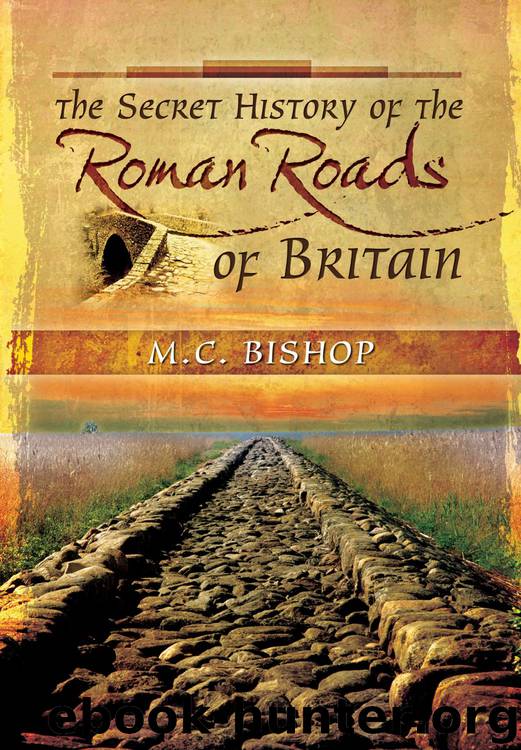The Secret History of the Roman Roads of Britain: And their Impact on Military History by M.C. Bishop

Author:M.C. Bishop
Language: eng
Format: epub
Tags: Bisac Code 1: HIS002000; HISTORY / Ancient / General
ISBN: 9781473837478
Publisher: Pen and Sword
Published: 2014-02-27T16:00:00+00:00
Boundaries
Roads were not just routes along which post-Roman military campaigns were conducted, however. They were frequently used to delineate property boundaries, most famously with the Watling Street acting as part of the border between Wessex and the Danelaw (it is even named in the treaty of c AD 886 drawn up between Alfred and Guthrun). The Fosse Way and Icknield Way are both mentioned in early charters, being used as boundaries, and Dere Street as a medieval boundary has already been mentioned (above page 41). This suggests that names had become attached to the old Roman roads fairly early on in the post-Roman period and some of these names were evidently generic: Watling and Ermin(e) Street are certainly still applied to more than one road. Many roads are still coincident with parish boundaries, virtually all of which are Anglo-Saxon in origin (although some may even relate to Roman villa estate boundaries) so this has come to be one of the means of identifying routes once they have fallen out of use.88
In a law of 1050, Edward the Confessor supposedly named the roads protected by the King’s Peace, these being ‘Watling Strete, Fosse, Hikenild Strete, and Erming Strete’. It is now impossible to be sure precisely which roads were intended, the only clue given being that two ran up and down (i.e. north to south) and two across England (east to west), but it is a not unreasonable assumption that these roads can be identified with those we know as Watling Street (Margary 1), the Fosse Way (Margary 5), Ryknild Street (Margary 18, rather than the Icknield Way, Margary 333), and Ermine Street (Margary 2, as opposed to Ermin Street, Margary 41). Similar legislation is enacted by later monarchs, reflecting their continuing importance.89
It was not only the roads themselves that were used as boundaries. We have already seen how the Rey Cross, a stone set up on the boundary of the Diocese of Glasgow and said to mark the site of the death of Eric Bloodaxe, may in fact have been on the site of a Roman milestation. There is also a tradition that the London Stone, now situated on the north side of Cannon Street but originally on the south side, at the entrance to what is thought to be the governor’s palace, may in fact be a Roman milestone or even a milliarium, a central milestone from which measurements along radiating roads were taken. It was certainly acting as a landmark and boundary stone in the ninth century AD, when it is mentioned, and continued to do so into the eighteenth century. As a manuport (it is made of oolitic limestone from the Chilterns) it has certainly been brought to the city, but the truth of its origins may never be known.90
Download
This site does not store any files on its server. We only index and link to content provided by other sites. Please contact the content providers to delete copyright contents if any and email us, we'll remove relevant links or contents immediately.
| Africa | Americas |
| Arctic & Antarctica | Asia |
| Australia & Oceania | Europe |
| Middle East | Russia |
| United States | World |
| Ancient Civilizations | Military |
| Historical Study & Educational Resources |
Room 212 by Kate Stewart(4956)
The Crown by Robert Lacey(4681)
Endurance: Shackleton's Incredible Voyage by Alfred Lansing(4620)
The Iron Duke by The Iron Duke(4240)
The Rape of Nanking by Iris Chang(4097)
Joan of Arc by Mary Gordon(3966)
Killing England by Bill O'Reilly(3922)
Say Nothing by Patrick Radden Keefe(3840)
I'll Give You the Sun by Jandy Nelson(3323)
Shadow of Night by Deborah Harkness(3252)
Hitler's Monsters by Eric Kurlander(3237)
Mary, Queen of Scots, and the Murder of Lord Darnley by Alison Weir(3118)
Blood and Sand by Alex Von Tunzelmann(3097)
Darkest Hour by Anthony McCarten(3036)
Margaret Thatcher: The Autobiography by Thatcher Margaret(2997)
Eleanor & Park by Rainbow Rowell(2992)
Red Famine: Stalin's War on Ukraine by Anne Applebaum(2843)
Book of Life by Deborah Harkness(2827)
The One Memory of Flora Banks by Emily Barr(2741)
